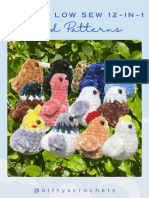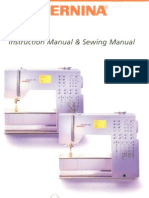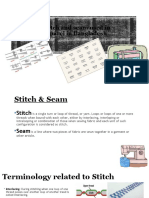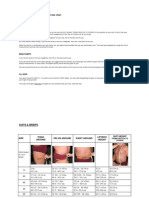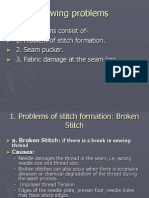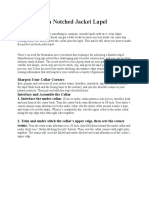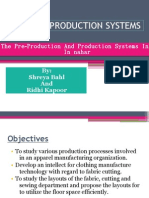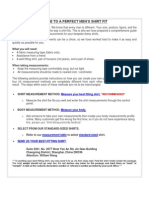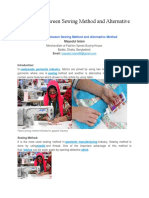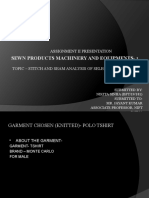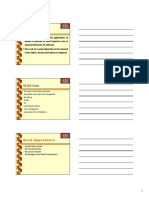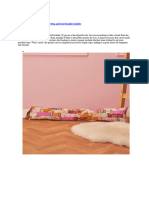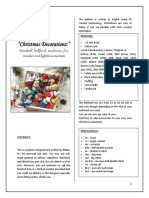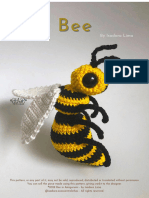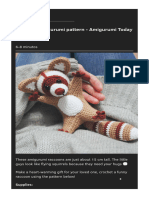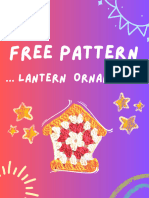3stitch Matrix 10 8 10
3stitch Matrix 10 8 10
Uploaded by
Shohan KhanCopyright:
Available Formats
3stitch Matrix 10 8 10
3stitch Matrix 10 8 10
Uploaded by
Shohan KhanOriginal Description:
Original Title
Copyright
Available Formats
Share this document
Did you find this document useful?
Is this content inappropriate?
Copyright:
Available Formats
3stitch Matrix 10 8 10
3stitch Matrix 10 8 10
Uploaded by
Shohan KhanCopyright:
Available Formats
ISO Stitch Terminology Page 1 of 4
Stitch Drawing
Top View As Sewn Bottom View As Sewn
ISO 4915
Number
Common
Application Requirements Stitch Description
Single Thread Blindstitch
Stitch is not visible on the
Outside of Sewn Product
103
Blindstitch
Blindstitch
Hemming,
Felling, Making
Belt Loops
Specify
1) SPI 3 - 5 SPI
2) Non-skip or 2 to 1
skipped stitch
Stitch is formed with one needle thread that is
interlooped with itself on the top side. The thread
passes through the top ply and horizontally through
portions of the bottom ply without completely
penetrating its full depth.
Lockstitch - Most Common of All
Stitches
Bobbin Thread on Bottom
301
Lockstitch
Single Needle,
Straight Stitching,
Topstitching
Specify SPI.
Stitch formed by a needle thread passing through the
material and interlocking with a bobbin thread with the
threads meeting in the center of the seam. Stitch looks
the same top & bottom.
Double Needle Lockstitch
Bobbin Thread on Bottom
301 2
Lockstitch
Double Ndl.
Topstitching
Specify SPI.
Stitch formed by 301 lockstitch machine with two
needles and two bobbins make two independent rows
of 301 lockstitch simultaneously.
Zig Zag Lockstitch
304
Zig Zag
Intimate Apparel,
Athletic wear,
Infantwear,
Exercisewear
Specify
1) SPI
2) Throw or width Zig-
Zag (1/8, 3/16, 1/4")
Stitch is formed with a needle and a bobbin that are
set in the center of the seam and form a symmetrical
zig-zag pattern. Also, used to identify bartacking and
lockstitch buttonsewing and buttonholing.
Chainstitch
Looper Thread on Bottom
401
Chainstitch
Single Needle
Chainstitch -
Mainseams on
Wovens
Specify SPI.
Stitch formed by 1-needle thread passing through the
material and interlooped with 1-looper thread and
pulled up to the underside of the seam.
2 Ndl.Chainstitch
Looper Thread on Bottom
401 2
Chainstitch
Double Needle
Seaming
Specify SPI.
Stitch formed by 401 chainstitch machine with two
needles and two loopers make two independent rows
of 401 chainstitch simultaneously.
2 Needle Bottom Coverstitch Looper Thread on Bottom
406
Bottom
Coverstitch
Hemming,
Attaching, Elastic,
Binding,
Coverseaming,
Making Belt
Loops
Specify
1) Needle spacing
(1/8, 3/16, 1/4")
2) SPI
Stitch formed by 2-needle threads passing through the
material and interlooping with 1-looper thread with the
stitch set on the underside of the seam. Looper thread
interlooped between needle threads providing seam
coverage on the bottom side only.
3 Needle Bottom Coverstitch Looper Thread on Bottom
407
Bottom
Coverstitch
Attaching Elastic
to Men's & Boys
Knit Underwear
Specify
1) Needle spacing
(1/4")
2) SPI
Stitch formed by 3-needle threads passing through the
material and interlooping with 1-looper thread with the
stitch set on the underside of the seam. Looper thread
is interlooped between needle threads providing seam
coverage on the bottom side only.
ISO Stitch Terminology Page 2 of 4
Stitch Drawing
Top View As Sewn Bottom View As Sewn
ISO 4915
Number
Common
Application Requirements Stitch Description
2 Thread Overedge
Single " purl" on Edge
503
1 Ndl.
Serging &
Blindhemming
Specify
1) Width Bite (Ex.
1/8", 3/16", 1/4")
2) SPI.
Stitch formed by 1-needle thread and 1-looper thread
with purl on edge of seam for serging or blindhemming
ONLY.
3 Thread Overedge
Common Overedge Stitch
504
1 Ndl.
Single Needle
Overedge
Seaming
Specify
1) Width Bite (Ex.
1/8", 3/16", 1/4")
2) SPI.
Stitch formed with 1-needle thread and 2-looper threads
with the looper threads forming a purl on the edge of the
seam. For overedge seaming and serging.
3 Thread Overedge
Double " purl" on Edge
505
1 Ndl.
Dbl. Purl
Serging with
Double purl on
Edge
Specify
1) Width Bite (Ex.
1/8", 3/16", 1/4")
2) SPI.
Stitch formed with 1-needle thread and 2-looper threads
with the looper threads forming a double purl on the
edge of the seam for serging ONLY.
Mock Safety Stitch
2 Needle Overedge
512
2 Ndl.
Seaming Stretch
Knits, Wovens
Specify SPI.
Stitch formed with 2-needle threads and 2 looper
threads with the looper threads forming a purl on the
edge of the seam. 512 right needle only enters the
upper looper loop. Stitch does NOT chain-off as well as
514 Stitch
2 Needle 4 Thread Overedge
2 Needle Overedge
514
2 Ndl.
Seaming Stretch
Knits, Wovens
Specify SPI.
Stitch formed with 2-needle threads and 2 looper
threads with the looper threads forming a purl on the
edge of the seam. 514 both needles enter the upper
looper loop. Preferred over 512 Stitch because it chains-
off better.
4 Thread Safetystitch
515
(401+503)
Safetystitch
Safetystitch
Seaming Wovens
& Knits
Specify
1) Needle spacing &
bite - Ex.: 1/8-
1/8", 3/16- 3/16"
3/16 1/4"
2) SPI
Combination stitch consisting of a single-needle
chainstitch (401) and a 2-thread Overedge stitch (503)
that are formed simultaneously. Uses less thread than a
516 stitch; however, many manufacturers prefer a 516
stitch.
5 Thread Safetystitch
516
(401+504)
Safetystitch
Safety Stitch
Seaming Wovens
& Knits
Specify
3) Needle spacing &
bite - Ex.: 1/8-
1/8", 3/16- 3/16"
3/16 1/4"
4) SPI
Combination stitch consisting of a single-needle
chainstitch (401) and a 3-thread Overedge stitch (504)
that are formed simultaneously.
ISO Stitch Terminology Page 3 of 4
Stitch Drawing
Top View As Sewn Bottom View As Sewn
ISO 4915
Number
Common
Application Requirements Stitch Description
2 Needle 4 Thread Coverstitch
602
Coverstitch
Binding A Shirts,
Infants Clothing,
etc.
Specify
1) Needle spacing
(Ex: 1/8", 3/16",
1/4")
2) SPI
Stitch formed with 2-needle threads, a top cover thread
and a bottom looper thread.
3 Needle 5 Thread Coverstitch
605
Coverstitch
Lap Seaming,
Coverseaming,
Binding on Knits
Specify
1) Needle spacing
(Ex: 1/4")
2) SPI
Stitch formed with 3-needle threads, a top cover thread
and a bottom looper thread.
4 Needle 6 Thread Coverstitch
Flatseamer/Flatlock
607
Flatseam
Coverstitch
Flat or Lap
Seaming Knit
Underwear,
Fleece, etc.
Specify SPI
Stitch formed with 4-needle threads, a top cover thread
and a bottom looper thread. Preferred over 606 stitch
because machines are easier to maintain.
BUTTONSEW, BUTTONHOLE, BARTACK
Stitch Appearance
ISO 4915
Number
Common
Application Requirements Stitch Description
Lockstitch Buttonsew,
Buttonhole or Bartack
Single Thread Chainstitch
Buttonsew
* 304 Lockstitch is
preferred when stitch
security is a Must.
101 chainstitch Buttonsew
with single thread
304
Lockstitch
101
Chainstitch
Buttonsew
Buttonhole
Bartack
1) Buttonsew -
specify stitches
per cycle (Ex.
8,16, 32)
2) BH - specify length
& width (1/2, 3/4",
1 )
3) Bartack specify
the length & width
of the tack
Buttonsewing can be done with either a single thread
buttonsewer or a lockstitch buttonsewer. Because
single thread sewn buttons can unravel if the stitch is
not locked properly, lockstitch sewn buttons is often
preferred. 2 hole buttons are usually sewn with 6 or 8
stitches. 4 hole buttons are normally sewn with 12 or
16 stitches.
Knit Shirts - Buttonhole length generally is 1/2 inch, is
placed horizontally, with approximately 85-90 stitches.
Most common bartack machines sew tacks with 28
stitches. Usually this includes running stitches that are
then overlayed with cross-over stitches.
ISO Stitch Terminology Page 4 of 4
You might also like
- Bird 12 in 1 Pattern - KittyxcrochetsDocument16 pagesBird 12 in 1 Pattern - KittyxcrochetsCinthya Melgar100% (3)
- Stitch People Cross Stitch 101Document8 pagesStitch People Cross Stitch 101redtrashpanda207No ratings yet
- Garden Bird Amigurumi PatternDocument38 pagesGarden Bird Amigurumi PatternMyriam Zuñiga Diaz100% (13)
- Eugene Specialknit82 8/5/2017Document6 pagesEugene Specialknit82 8/5/2017Yadi Roma100% (2)
- Fall Bluff Raglan Sweater - 02 18 22Document4 pagesFall Bluff Raglan Sweater - 02 18 22Wyne Ci100% (4)
- Flat KnittingDocument9 pagesFlat KnittingJuhi NathNo ratings yet
- Bernina 150 160Document66 pagesBernina 150 160Terri Hipsher75% (4)
- Denim Stitch Matrix 2Document4 pagesDenim Stitch Matrix 2atulpvermaNo ratings yet
- Seams and StitchesDocument21 pagesSeams and StitchesVaanazhaganNo ratings yet
- The Natty TopDocument15 pagesThe Natty TopRenata Manzzo100% (1)
- Carr and Latham's Technology of Clothing ManufactureFrom EverandCarr and Latham's Technology of Clothing ManufactureDavid J. TylerRating: 4 out of 5 stars4/5 (1)
- Doll MermaidDocument21 pagesDoll MermaidCarolina Abarca Miranda60% (5)
- Denimstitchmatrix2 PDFDocument4 pagesDenimstitchmatrix2 PDFK.s. RameshNo ratings yet
- Stitch GuideDocument8 pagesStitch GuidefelipeNo ratings yet
- A&estitchseamdefectsDocument5 pagesA&estitchseamdefectsTee CeeNo ratings yet
- 8.STITCHES & ClassificationDocument56 pages8.STITCHES & ClassificationUmer MushtaqNo ratings yet
- Assignment of Stitch Class and Sub-Class Including All Features and UsesDocument25 pagesAssignment of Stitch Class and Sub-Class Including All Features and UsesJahidul IslamNo ratings yet
- Stitch Classes and Stitch DefectsDocument59 pagesStitch Classes and Stitch DefectsMaanvizhi Moorthi100% (2)
- Seams AnalysisDocument48 pagesSeams AnalysisShovon June100% (1)
- Stitch TypesDocument57 pagesStitch TypesOjasvi Agarwal100% (1)
- Stitch 140503091259 Phpapp01Document35 pagesStitch 140503091259 Phpapp01Steve ShamNo ratings yet
- Assignment On Different Stitch and Seam Used in Knitwear ApparelDocument30 pagesAssignment On Different Stitch and Seam Used in Knitwear ApparelAnisur Rahman GeorgeNo ratings yet
- 100 Class StitchesDocument9 pages100 Class StitchesVishakha ChopraNo ratings yet
- BixbyDocument19 pagesBixbyjoynahidNo ratings yet
- Stitch ClassificationDocument27 pagesStitch Classificationrgvarma123No ratings yet
- Garment Defect Analysis: Case Study: Women Denim Shorts Subject: Ass & QCDocument11 pagesGarment Defect Analysis: Case Study: Women Denim Shorts Subject: Ass & QCshalu singhNo ratings yet
- How To Measure - Tops - 4.6.20 (8-19-2020)Document45 pagesHow To Measure - Tops - 4.6.20 (8-19-2020)Vũ TươiNo ratings yet
- Final Jeans ReportDocument9 pagesFinal Jeans ReportManas DasNo ratings yet
- Knitting TechnologyDocument2 pagesKnitting TechnologymichuttyNo ratings yet
- Needle: Functions of Needle in The Sewing M/CDocument11 pagesNeedle: Functions of Needle in The Sewing M/CDewan Ajuad Hossain RifatNo ratings yet
- Basic Shirt MeasurementDocument3 pagesBasic Shirt MeasurementImran TexNo ratings yet
- Fabric Finishing Process and TreatmentDocument5 pagesFabric Finishing Process and TreatmentSwarnim DobwalNo ratings yet
- Seam, Classification of Seam, Features of Seam, Uses of SeamDocument13 pagesSeam, Classification of Seam, Features of Seam, Uses of SeamJahidul Islam100% (1)
- 01/2012 3212049 Article Season Supplier Sbms Programm KollektionDocument3 pages01/2012 3212049 Article Season Supplier Sbms Programm KollektionSubramanya RaoNo ratings yet
- ContentDocument11 pagesContentSHASHANK ROHITNo ratings yet
- CT MMB 198Document2 pagesCT MMB 198Rosana Barakat100% (1)
- Tech Pack - Formal Long Sleeve Shirt (1) (1) .ITQWT20Document2 pagesTech Pack - Formal Long Sleeve Shirt (1) (1) .ITQWT20joynahidNo ratings yet
- Patonaje Niños 3Document100 pagesPatonaje Niños 3miguel martinezNo ratings yet
- Garment DefectsDocument5 pagesGarment DefectsSayed Aasim JawaidNo ratings yet
- For All Types: Metal Sport and Wear's Official Size ChartDocument8 pagesFor All Types: Metal Sport and Wear's Official Size ChartJoel BurnsNo ratings yet
- Spme Denim TrouserDocument45 pagesSpme Denim TrouserSupriya Nanda50% (2)
- FM Assignment: Proto Tech PackDocument16 pagesFM Assignment: Proto Tech Packluckyharsh19No ratings yet
- Urbana Urbana: Extra Button On Wash Care Label On Side SeamDocument6 pagesUrbana Urbana: Extra Button On Wash Care Label On Side Seamrajivranjan3490No ratings yet
- Button Hole StitchesDocument41 pagesButton Hole StitchesEruNo ratings yet
- Seam and Its TypesDocument33 pagesSeam and Its Typessaranya narenNo ratings yet
- Sewing ProbDocument18 pagesSewing ProbAminur RahmanNo ratings yet
- Notched Jacket LapelDocument6 pagesNotched Jacket Lapelwasyihun100% (1)
- Knitted FabricsDocument24 pagesKnitted Fabricsapi-232403733No ratings yet
- Garment Production and Machinery EquipmentsDocument31 pagesGarment Production and Machinery EquipmentsShreya Bahl100% (1)
- 007 Capitulo 7Document12 pages007 Capitulo 7whilmeragudelo100% (1)
- Stitch ClassesDocument47 pagesStitch ClassesBindu BasannaNo ratings yet
- Men - Shirt - Measureguide Processo de Producao de Camisa Alfaiataria HomemDocument17 pagesMen - Shirt - Measureguide Processo de Producao de Camisa Alfaiataria Homemarouz_m2078No ratings yet
- Wal-Mart Canada Missy: LabelDocument4 pagesWal-Mart Canada Missy: LabelsalyNo ratings yet
- 2.2 Determining Stretch Ratio-Example-new PDFDocument1 page2.2 Determining Stretch Ratio-Example-new PDFmeganNo ratings yet
- Defects of GarmentsDocument10 pagesDefects of GarmentsSîronamHin MonirNo ratings yet
- Difference Between Sewing Method and Alternative Method4Document40 pagesDifference Between Sewing Method and Alternative Method4sabberNo ratings yet
- Sewn Products Machinery and Equipments-: Assignment Ii PresentationDocument7 pagesSewn Products Machinery and Equipments-: Assignment Ii PresentationNiharika SinhaNo ratings yet
- Woven Pant Consumption FormulaDocument16 pagesWoven Pant Consumption FormulaRabi KantNo ratings yet
- SeamsDocument17 pagesSeamsNidhi Shah0% (1)
- Pembinaanpolapakaian 151202025143 Lva1 App6891Document84 pagesPembinaanpolapakaian 151202025143 Lva1 App6891Aiman FitriNo ratings yet
- Theory of Silk Weaving A Treatise on the Construction and Application of Weaves, and the Decomposition and Calculation of Broad and Narrow, Plain, Novelty and Jacquard Silk FabricsFrom EverandTheory of Silk Weaving A Treatise on the Construction and Application of Weaves, and the Decomposition and Calculation of Broad and Narrow, Plain, Novelty and Jacquard Silk FabricsNo ratings yet
- LILLAby Zoya Matyushenko ENGDocument8 pagesLILLAby Zoya Matyushenko ENGMeilysa Yoe100% (1)
- Tip Top Tank Fine v1.2Document6 pagesTip Top Tank Fine v1.2nguyenhongv8100% (1)
- Davies Kate - Buachaille - 2015Document84 pagesDavies Kate - Buachaille - 2015susanaNo ratings yet
- Toys by Ustyushka - Oliver The GnomeDocument27 pagesToys by Ustyushka - Oliver The GnomeSilvina67% (3)
- Chapter 2 - The Technique of KnittingDocument5 pagesChapter 2 - The Technique of Knittingtoolika25473No ratings yet
- Rainbow: UnityDocument10 pagesRainbow: UnityLucy EF100% (1)
- Draught ExcluderDocument2 pagesDraught ExcluderWestwickateNo ratings yet
- Wrapped in CrochetDocument8 pagesWrapped in CrochetInterweave66% (38)
- Haze Sweater ENG 1.0Document16 pagesHaze Sweater ENG 1.0Dolores Gil100% (3)
- Mario Ages PDFDocument7 pagesMario Ages PDFNancy CarSanNo ratings yet
- Shoulder BagllllDocument8 pagesShoulder BagllllApoorva GowdaNo ratings yet
- PrincipitoDocument22 pagesPrincipitoDiego De Jesús Salazar SoteloNo ratings yet
- Christmas Decoration Set12Document30 pagesChristmas Decoration Set12Beatriz Restrepo G100% (1)
- Click Here For Free Patterns: Crochet Whale CrochetDocument12 pagesClick Here For Free Patterns: Crochet Whale CrochetBlack Darck100% (6)
- Bee Amigurumi by Isadora LimaDocument12 pagesBee Amigurumi by Isadora LimapaseoferiarteolivaNo ratings yet
- Masco Printing & Embroidery Limited: Quotation For ArtworkDocument2 pagesMasco Printing & Embroidery Limited: Quotation For ArtworksatexNo ratings yet
- Raccoon Amigurumi Pattern - Amigurumi TodayDocument9 pagesRaccoon Amigurumi Pattern - Amigurumi TodayXochilt Sanchez100% (3)
- Hook HO: SunshineDocument130 pagesHook HO: Sunshineester100% (5)
- Chubby Frogs 2021 1 Instagram @rin - Meow21Document8 pagesChubby Frogs 2021 1 Instagram @rin - Meow21nannae2103100% (1)
- Petirrojo - Ave Amigurumi GanchilloDocument2 pagesPetirrojo - Ave Amigurumi Ganchilloanna_wellbelovedNo ratings yet
- Free Crochet Pattern - Ornament LanternDocument12 pagesFree Crochet Pattern - Ornament LanternL0veCr0chetNo ratings yet
- Cherry Blossom in The Snow - Jen Tyler 2016Document10 pagesCherry Blossom in The Snow - Jen Tyler 2016lectora100% (1)
- Knitting ScienceDocument24 pagesKnitting ScienceKathirrveluSubramainanNo ratings yet
